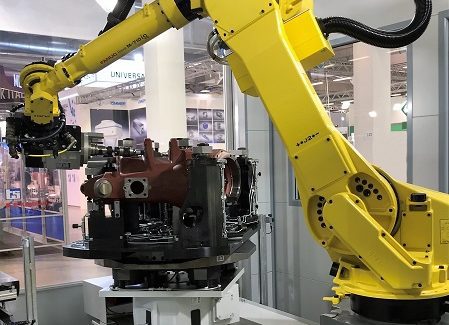Flexible Robotic Precision Finishing Systems
Robotic finishing systems from Fastems eliminate variations that are common in hand-finishing operations, maximize the output of consistently precise parts, and relieve employees of tedious and tiring hand finishing activities.
Posted: February 1, 2019
Robotic finishing eliminates variations that are common in hand-finishing operations and maximizes the output of precisely-finished parts. Fastems LLC (West Chester, OH) offers a comprehensive range of automated robotic finishing systems, including grinding, polishing, deburring and brushing processes that provide speed and flexibility through a combination of control and software technology, spindle choices, and a variety of process tools and accessories. As an independent integrator of robots systems for all major brands (including FANUC, KUKA and others on customer request), Fastems makes both pneumatic and electric spindles available when assembling robotic finishing systems, depending on which approach provides the best performance for certain applications. Pneumatic spindles have programmable compliance that enables tools to compensate for part feature variations, such as those typical in castings. Pneumatic spindles are generally fitted with a single tool and are used in applications that do not require several different tools.
Electric spindles, on the other hand, are suited to applications that require a large number of tools or where tool changes are frequent. Electric spindles provide ample power, feature programmable rotational speeds and permit accurate tracing of control variables. A large selection of tooling for either type of spindle enables users to custom-tailor processes for specific applications. Process tools include burrs, brushes, grinding stones, abrasive and flap-style wheels, as well as specially engineered tools. Both on-line and off-line programming options are provided: For product families with relatively limited variations, on-line programming at the finishing cell is a quick and time-efficient system. For parts that change frequently and have complex geometries, programming off-line employs FASTSIMU off-line programming software that combines feature-based CAD models with CAM path-based toolpath programming to facilitate the creation of complex robotic programs off-line while the finishing cell operations continue uninterrupted.
A selection of engineered accessories enables users to customize robotic finishing systems to fit their own part requirements and shop conditions. These options include spindle cooling systems, tool presence sensors, application-specific process control sensors and Renishaw touch probes. Spindle and tool cabinets are offered for use with electric spindles, and spindle racks for applications employing pneumatic spindles. Environmental and ergonomic accessories, such as sound-isolated or flush-proof housings and dust and fume extraction systems, are also available. “These automated finishing systems enable users to save time, produce consistently precise parts, and relieve their employees of tedious and tiring hand finishing activities,” said David Suica, the president of Fastems LLC, a wholly-owned subsidiary of Fastems Oy Ab (Tampere Finland).
Fastems LLC, 9850 Windisch Road, West Chester, OH 45069, 513-779-4614, Fax: 513-779-4638, www.fastems.com.














